Getting A Handle On America’s Favorite .22 Rifle

Considering some Ruger 10/22 stocks to customize your .22LR plinker? They’re fun rifles to customize, but – is the customization worth it?
Bob Back Story
I bumped into an old friend the other day and, as always, the conversation quickly turned to firearms. My buddy Bob was in the market for an “accurate” .22 LR and had his sights set on a semiautomatic Ruger 10/22. But, which one? Between the factory options and custom possibilities, the choices seemed overwhelming.
With over seven million sold since its 1964 debut, Ruger’s 10/22 can rightfully claim the title of America’s top-selling “twenty-two.” Named for its novel 10-shot rotary magazine, the overall success of the rifle has spawned close copies along with lots of aftermarket parts and accessories.
As Bob was well aware, I was among those who’d done a fair share of 10/22 tinkering. The Ruger’s innovative design is perfect for kitchen table customizations that encompass everything from barrels through stocks. Often times the only remaining factory part is a Ruger receiver – which pretty much describes my current version.

Today though, the possibilities are such that you could create an entire “10/22” rifle without using any Ruger parts whatsoever. The main extent of my customization efforts involved a different stock, heavy-contour “match-grade” barrel, and tuned trigger.
The objective was accuracy and that goal was met. Using decent optics and match-grade .22 LR loads, many 5-shot groups hover around ½” at 50 yards; one moa performance.
Seizing on Bob’s accuracy comment, I began rattling off some technical details. But, it quickly became apparent that Bob’s interest was fading. After a quick time-out the mission was redefined; he was after a tractor gun! The accuracy requirements? The targets would be garden raiding woodchucks or pigeons on the roof of his barn, most within forty yards.
The ammunition would be whatever bulk-pack JHPs were available. Optics were a maybe. The bigger concern was wet grass and cow dung. So much for assumption. Free advice, too. Had Bob followed mine he would’ve blown several hundred dollars.
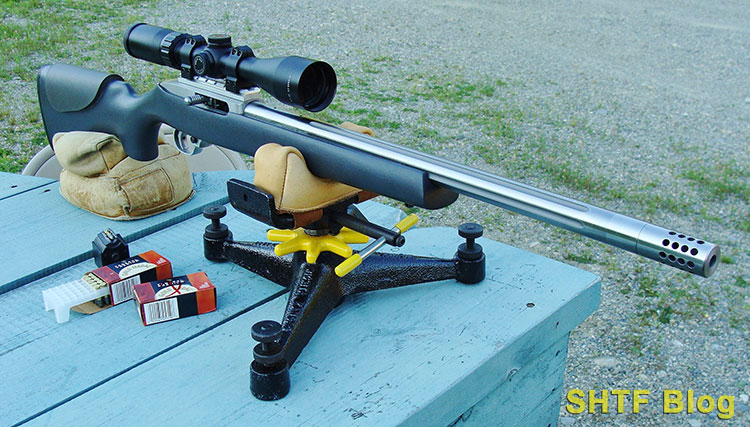
Different Strokes for 10/22 Folks
Bob’s 10/22 interest was utility-based and mine focused on accuracy, but a third category of Ruger fanciers also come to mind; those seeking cool-looking firearms. The eye candy possibilities draw many shooters to the Ruger design, along with several close copies. Although these creations stand in stark contrast to a plain vanilla 10/22, nearly all of them share a common foundation: the receiver.
The 10/22 is a great design for hobby gunsmiths because of its receiver/barrel mounting system. The barrel is secured by tension on a crossbar-clamp which engages a dovetail on its underside. Because two strong cap-screws draw everything together, exchanging a barrel only requires an Allen wrench.
The trigger housing is another win. It’s self-contained and captured by two cross-pins. Removal of the stock exposes the receiver for easy access of the innards, again, using simple hand tools.
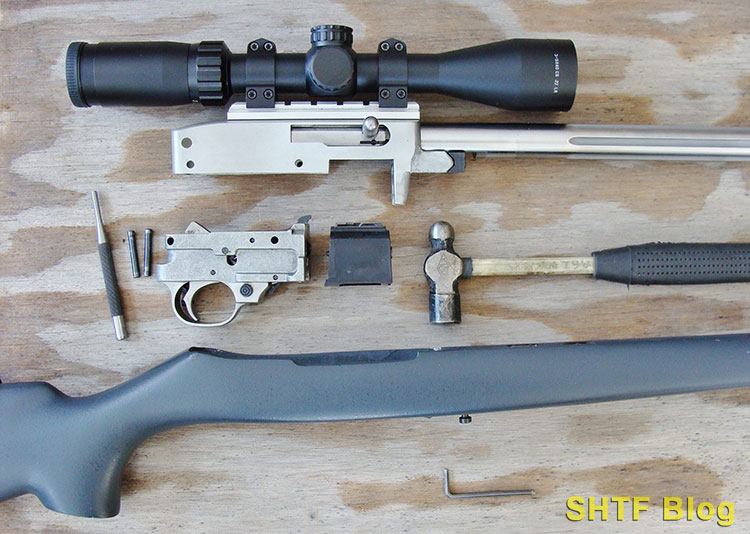
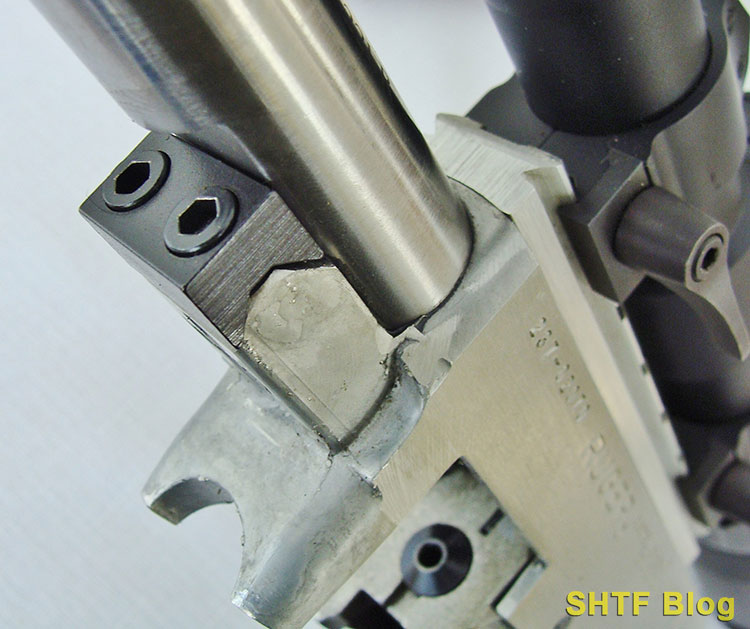
Although some custom creations have a wild side, most are the product of an aftermarket barrel and stock. Barrel contours vary so one stock won’t fit everything, however, plenty of interesting combinations are possible once their differences are understood.
Barrel Background
Most 10/22 barrels are either standard-weight or heavy “bull-barrel” designs. Their lengths can vary but the majority will fit stocks advertised for these contours.
Standard Barrels
These barrels are tapered per Ruger’s basic 18 ½” 10/22 design, and most are designed to accommodate open sights. They’re a great utilitarian choice capable of digesting just about any available 22 LR cartridges. Ruger catalogs a Sporter version sans sights and a forward barrel band, but the barrel contour is similar.
Heavy Barrels
Sold in different lengths, the thicker .920” diameter results in a stiffer barrel. The extra mass is more conducive to peak accuracy, usually at the expense of a heavier rifle. However, some H.B. designs are surprisingly light due to the use of steel liners sheathed with carbon fiber or aluminum sleeves. If matched with a lightweight stock overall weight can be no more than a standard carbine, although the cost will be much more.
Barrel Notes: HB barrels don’t use a barrel band. Some also have tighter match-type chambers that can fail to extract loaded cartridges. Others, built in oddball lengths and contours may not fit the common stock patterns.
Ruger 10/22 Stock Options
To achieve a proper stock fit, the main consideration is the width of the barrel channel relative to the barrel. Although the primary concern is fit, another involves aesthetics.
Shop Ruger 10/22 Stocks at Brownell’s
Shop Ruger 10/22 Stocks at Optic’s Planet
Standard Stocks
While you could use just about any 10/22 stock with a sporter barrel, the result could be an unsightly gap. No worries though. Most sporter stocks are geared for utility, which means they often cost less. Most, including the Ruger types, are either beech or molded plastic.
The latter is pretty much impervious to the elements. Because thinner barrels and stocks are more susceptible to external influences (like grip tension) they seldom produce top-flite accuracy, but for many practical users, they’ll do just fine.
Heavy-Barrel Stocks
Some HB stocks can be pedestrian, and it’s possible to modify a standard stock, but the majority of HB stocks are marketed for those seeking peak accuracy, ultra-cool custom 10/22s – or even both rolled into one neat rifle! Surprisingly, some of the more exotic stocks aren’t prohibitively expensive.
Constructed from laminations of dyed wood with racy contours, the result can be a dazzling creation – especially when jazzed up by a stainless barrel with wild flutes. Other stocks are constructed from hand-laid fiberglass painted with exotic patterns. With attention to details many custom 10/22s will also drive tacks!
The 10/22 Portfolio
Thanks to the internet, a mind-numbing assortment of 10/22 examples can be seen; everything from basic factory Rugers to high-end rimfire race-guns. For my buddy Bob though, some time spent watching a few Alaskan-based TV programs could be the better first step to a more prudent choice. Same for preppers or others in gnarly places.
Utility 10/22s
From the perspective of my couch, it’s evident that many residents of the Alaskan bush are equipped with a common implement; namely a .22 rifle. It could be slung crosswise over a parka, stuffed in a dog sled, or lashed to a snowmobile. It’ll also receive a constant drubbing from brush and the elements. And, as often as not, the rifle will be a pretty basic Ruger 10/22.

Beyond a testament to the reliability of the 10/22’s design, this strategy makes plenty of sense. With bears off the threat-list due to winter hibernation, the next big concern is survival. A well-placed .22 LR bullet offers the means to pot a grouse or rabbit (snowshoe hare), a big plus when running a trapline.
Although “accuracy” matters to some extent, the system needs to be reliable and weatherproof. Most of the 10/22s look to be stainless/synthetic-stocked models with open sights. If the Ruger’s magazine is ever lost, there’s some comfort through abundant spares.
I haven’t noted any takedown models, which makes sense given that dinner could be a target of opportunity. But, you can buy a Ruger 10/22 configured as such, or even modify your own Ruger 10/22 takedown. When disassembled, it’ll fit in lots of small spaces.
Back to Ol’ Bob: He should do just fine with a similar basic 10/22, available in several versions as a new or used rifle. If he gets the itch, it can always be upgraded later thanks to the vast assortment of aftermarket options.
Or, for owners of dinged-up wood-stocked models, just pull off the stock and paint it in the color of your choice. Textured paint sprays are available from Brownell’s. Done right, the finished product may bear a strong resemblance to the Ruger target model described below.

Standard stocks are typically secured to the action using one machine screw and a barrel band that encircles the forend tip. Its design can accommodate a QD sling swivel, and some aftermarket versions have provisions to mount lights, etc.
Accurate and Racy 10/22s
The requirements for peak 10/22 accuracy are similar to a bolt-action rifle; a rigid barrel, properly fitted to an action, which is securely bedded to the stock. Bolt-guns are typically “free-floated” to provide clearance between the barrel and stock channel. The steel action may be glass-bedded (with an epoxy mix) to the stock, to ensure a consistent fit maintained by two strong bolts.
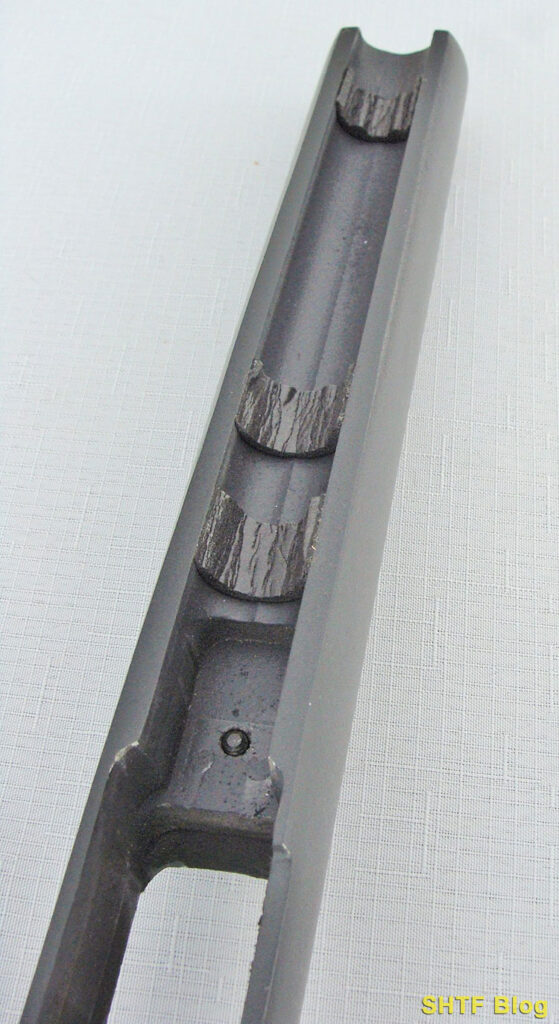
The challenge for 10/22 owners is its design. The receiver is aluminum and only employs one stock bolt. Target-type 10/22s dispense with the barrel band to eliminate its negative influences, so the one remaining connection is the bolt.
People have tried various tricks to eliminate minor play – one being a reversed process where the barrel is fully glass-bedded and the action is free-floated in the stock. Others with the requisite skills add an extra bolt to the rear of the receiver – an improvement Ruger finally added to their Competition models.
I went a different route for my HB 10/22 creation. I “bedded” its older Brown Precision fiberglass stock to a Volquartsen HB barrel, using three cradles of compressible weatherstripping (a trick I’ve done before with success). That step, combined with new trigger parts, tightened up its groups.
Further improvement may be possible with a minimum-headspace bolt, but so far I’ve avoided a deeper dive down the 10/22 rabbit hole.
Shooters interested in really cool-looking rimfires have plenty of great options, but for maximum accuracy, a stiffer stock should trump racy lines. My son’s lightweight Tactical Solutions is a proprietary 10/22 rendition that manages to check off most of the “plus” boxes through an aluminum-composite barrel, and MagPul synthetic stock. Its accuracy should satisfy all except those chasing the ultimate tack-driver.

The Bottom Line
The above was presented as an overview of 10/22 stocks. It may also beg a question: Is a tricked-up 10/22 actually worth the investment?
You can shop a whole variety of 10-22 stocks at Brownell’s, but for most of us, the answer to whether it’s worth it will be cost related.
However, there is no shortage of on-line information, to include barrel dimensions, compatible stocks, and hard-to-resist accessories. Be sure to sit on your wallet while surfing the net – and also consider the objective.
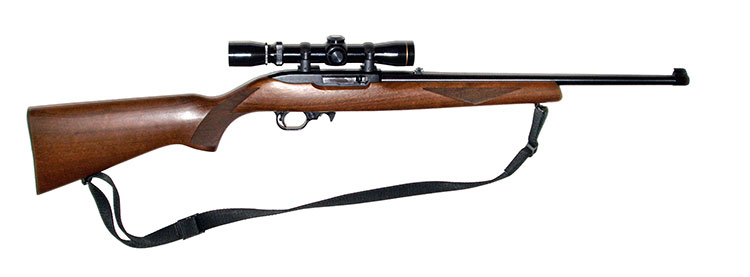
Shop Ruger 10/22 Stocks at Brownell’s
Shop Ruger 10/22 Stocks at Optic’s Planet
From a practical viewpoint, especially with prepper use factored in, most extra widgets won’t improve the already reliable basic design, but they will incur additional expense. Which brings us full-circle back to accuracy and how much is “enough”.
It’s been my experience that most garden variety 10/22s are capable of drilling five .22 LR bullets into a one-inch circle at 50 yards – with a caveat: Some trial and error may be necessary via different loads – and a proper scope.
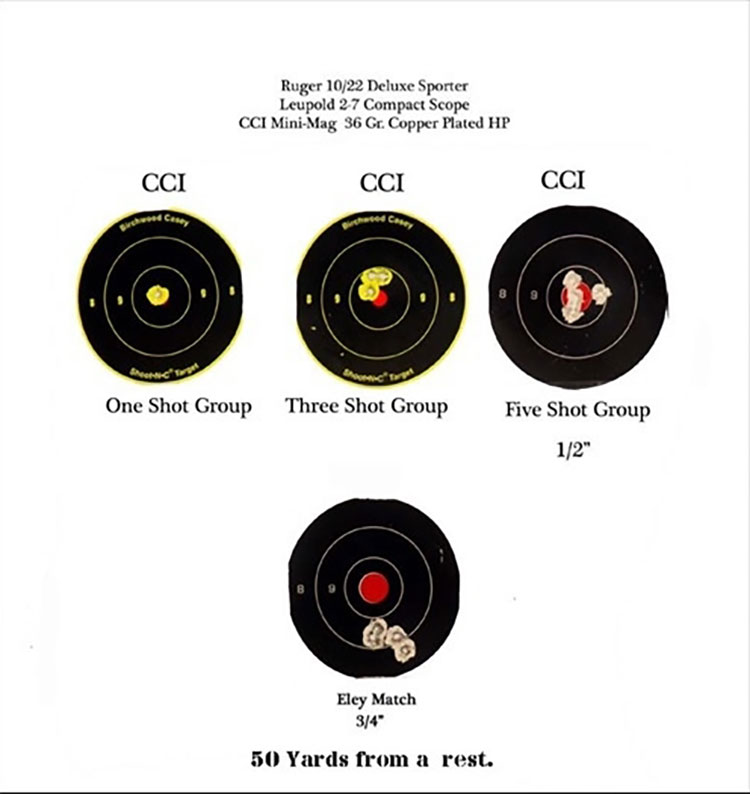
Custom Build Or Factory?
Do-it-yourself custom gunsmithing projects can be lots of fun. For those inclined to dabble with a 10/22, the world is your oyster. If not, there plenty of off-the-shelf options from semi-custom manufacturers – not to mention Ruger!
Want a gussied-up target-type rimfire? The accuracy of Ruger’s 10/22 Competition may not equal a carefully assembled custom build but it should come close. FYI, despite their appearances, all of the Competition models (including a new LH version) have laminated stocks. Those that resemble synthetic versions are simply coated with textured paint.
Another option: To save a bunch of money, just buy a basic 10/22 and be done with it.
Want more information on all things rimfire? Steve Markwith is also the author of Rimfire Rifles: A Buyer’s and Shooter’s Guide.
- Markwith, Steve (Author)
- English (Publication Language)
- 182 Pages - 09/28/2015 (Publication Date) - Prepper Press (Publisher)


1 comment
Interesting article, but maybe I’m wrong here in my thinking, but I’ve been playing with the idea of a folding stock for a 1022 with either a red dot or 1- 6 x 30 or something similar with a flip off scope base or a see though scope base. Something that will fit in back pack maybe .